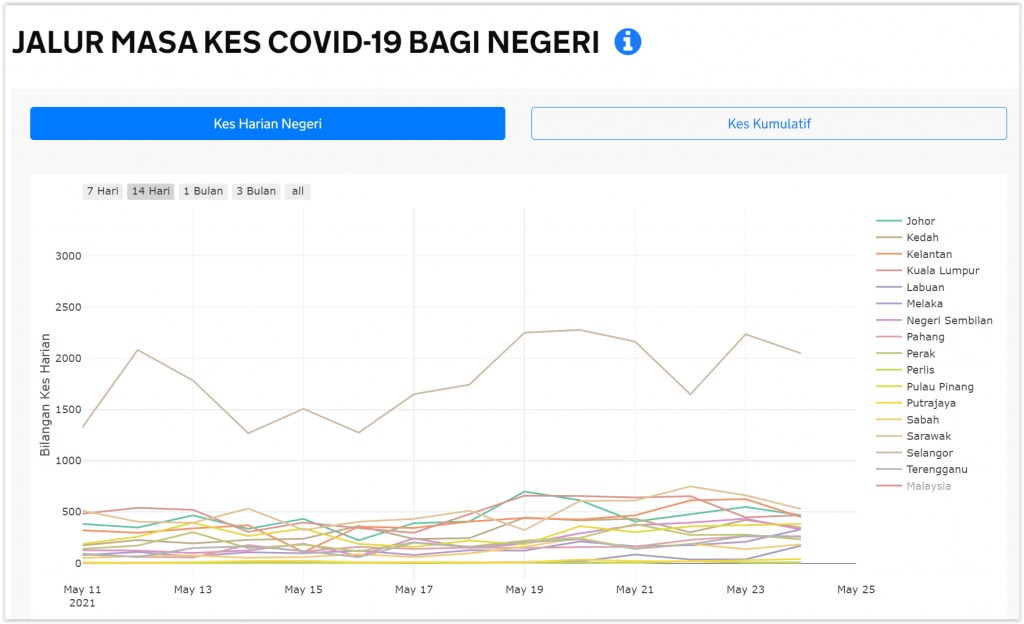KUALA LUMPUR, May 27 — A dashboard that tracks Covid-19 cases, deaths, vaccination, and mobility data in Malaysia showed mistakes upon its launch by Opposition Leader Anwar Ibrahim yesterday.
Anwar, who officiated the virtual launch of the PascaCOVID-19 Dashboard (DPC19) initiative by Yayasan Harapan, a charity, said the dashboard is a platform that invites stakeholders from all walks of life and the international community to collaborate and share ideas to help bring Malaysia and the people out of the Covid-19 pandemic.
Wan Muhamad Hasni Wan Sulaiman, the executive president of the DPC19 initiative who is also founder of Yayasan Harapan, stated that data available in the dashboard was obtained from publicly available data.
Here, CodeBlue would like to highlight several serious data discrepancies in the PascaCovid dashboard.

Firstly, the cumulative Covid-19 vaccination rate (total number of people who received at least one dose or completed both doses) in each state is delayed by a day in the dashboard. For instance, the vaccination data on May 23 is recorded under May 24. This mistake persists throughout the entire time period tracked from May 3. The dashboard does not track shots to the arm administered daily either.
The map showing coronavirus vaccination coverage — delineated according to “low”, “medium”, and “high”, without accompanying measurement definitions — also colours Sabah as “medium” and Sarawak as “low”, even though Sarawak has higher inoculation coverage than Sabah.
The dashboard states that its Covid-19 vaccination graphs show the “number of Malaysians who have been vaccinated among Malaysians who have registered for the National Covid-19 Immunisation Programme (PICK)”.
Official vaccination data from the Special Committee for Ensuring Access to Covid-19 Vaccine Supply (JKJAV), however, does not differentiate between Malaysians and non-nationals who sign up or receive their shots under PICK.
As the vaccination graph in the dashboard is meant to display the number of people who have received Covid-19 vaccination, the legend should be labelled as the “number of people who have received at least one dose” and the “number of people who have completed two doses”, rather than the current “first dose” and “second dose” labels.
A “first dose” label could give the mistaken perception that it refers to the number of people who received only one vaccine dose so far. The number of people who have received at least one dose comprises both those who got only one dose and those who completed two doses for full vaccination. Malaysia’s drug regulators have yet to approve the single-shot CanSino coronavirus vaccine that the government has ordered.
JKJAV’s daily vaccination graphics similarly use the misleading “first dose” and “second dose” labels, although Health Minister Dr Adham Baba’s daily tweets of the graphics clearly specify the number of people who have received at least one dose, including the number of those who received both doses.
The PascaCovid dashboard also bases its vaccination coverage on those who have registered for Covid-19 vaccination, rather than coverage of the total population or the population aged 18 and above. Covid-19 vaccines in Malaysia are currently only approved for use in adults. As of yesterday, only about 11 million people have registered for their shots, about a third of the 32.7-million population.
Wan Muhamad Hasni, who acknowledged the discrepancies, told CodeBlue that the team will rectify all the errors as soon as possible.
Covid-19 Case, Death Data

On Covid-19 case and death data, the PascaCovid dashboard segregates states on the Malaysian map into “low”, “medium”, and “high”, but does not define how these are measured.
The PascaCovid dashboard tracks daily and cumulative Covid-19 cases and deaths officially reported by the Ministry of Health (MOH) according to state by time periods of seven days, 14 days, one month, three month, and since the start of the Malaysian epidemic, as well as infections and fatalities reported nationwide in the past seven and 14 days.
Data on daily new, active, and cumulative Covid-19 cases by district is available on the dashboard too.
However, the dashboard does not feature incidence rates based on new Covid-19 cases or prevalence rates based on active cases, which would show more accurately which states or districts are hit harder by the virus than others when adjusting for population size. MOH does not regularly publish Covid-19 incidence and prevalence rates.
The PascaCovid dashboard also, unfortunately, does not feature testing data or the positive rate (share of tests that are positive). The federal MOH and the Sarawak state government publish daily testing data, although one has to manually calculate the number of people tested daily as MOH and Sarawak only provide the cumulative number of people tested as of the day.
Nor does the dashboard tabulate Covid-19 fatalities according to gender or age, or brought-in-dead cases.
Mobility Data

The PascaCovid dashboard features mobility data in Malaysia nationwide, by state, and by district, such as movements to grocery stores, supermarkets, or pharmacies, residences, transit stations, shopping centres, parks, workplaces, shopping centres, and recreational places. The mobility data is collated from Google.
It is unclear how such mobility data can be used to determine the public health response to the surging Covid-19 epidemic, although it may be somewhat helpful in seeing if lockdown measures have successfully curbed people’s movements.
Wan Muhamad Hasni, however, told reporters yesterday that this dashboard is another supplementary element to assist the government to make projections and to implement the right policies to combat Covid-19.
“For instance, if you look at the rising trend of mobility data, we know for sure that the cases will rise. So by looking at the trend, we should tell people to reduce their movement rate. There is no point if we keep saying that the cases are rising only,” Wan Muhammad Hasni added.
According to Anwar, the PascaCovid dashboard is aimed to educate and raise public awareness on the Covid-19 situation through comprehensive data sharing by establishing a platform to collect, filter, analyse and share data with interested and committed parties for additional research, analysis and improved decision making.
“I sense the people of Malaysia are growing angry and frustrated with the policies regarding the pandemic, which are seen to be directionless and ineffective,” Anwar said.
“The government is not supposed to hope for a solution. The government is supposed to inspire hope in the people. Instead, I sense hopelessness. To move forward we need more collaboration and openness. The PSPC19 (Post Covid-19 Strategic Programme) will contribute to this inclusive, collaborative, problem solving approach.”
The Port Dickson MP also mentioned that the data will be useful to recommend solutions to improve the Covid-19 vaccination strategy, provide assistance to the public affected by movement restriction orders, as well as for the economic recovery of the nation, without elaborating.
At the same time, Wan Muhamad Hasni pointed out that the government is not releasing granular and timely data.
“There are daily reports by the Ministry of Health (MOH). Even the daily reports by the state, there are a lot of errors. But I don’t want to argue about that. I don’t even know how to verify that. That is the problem.”








